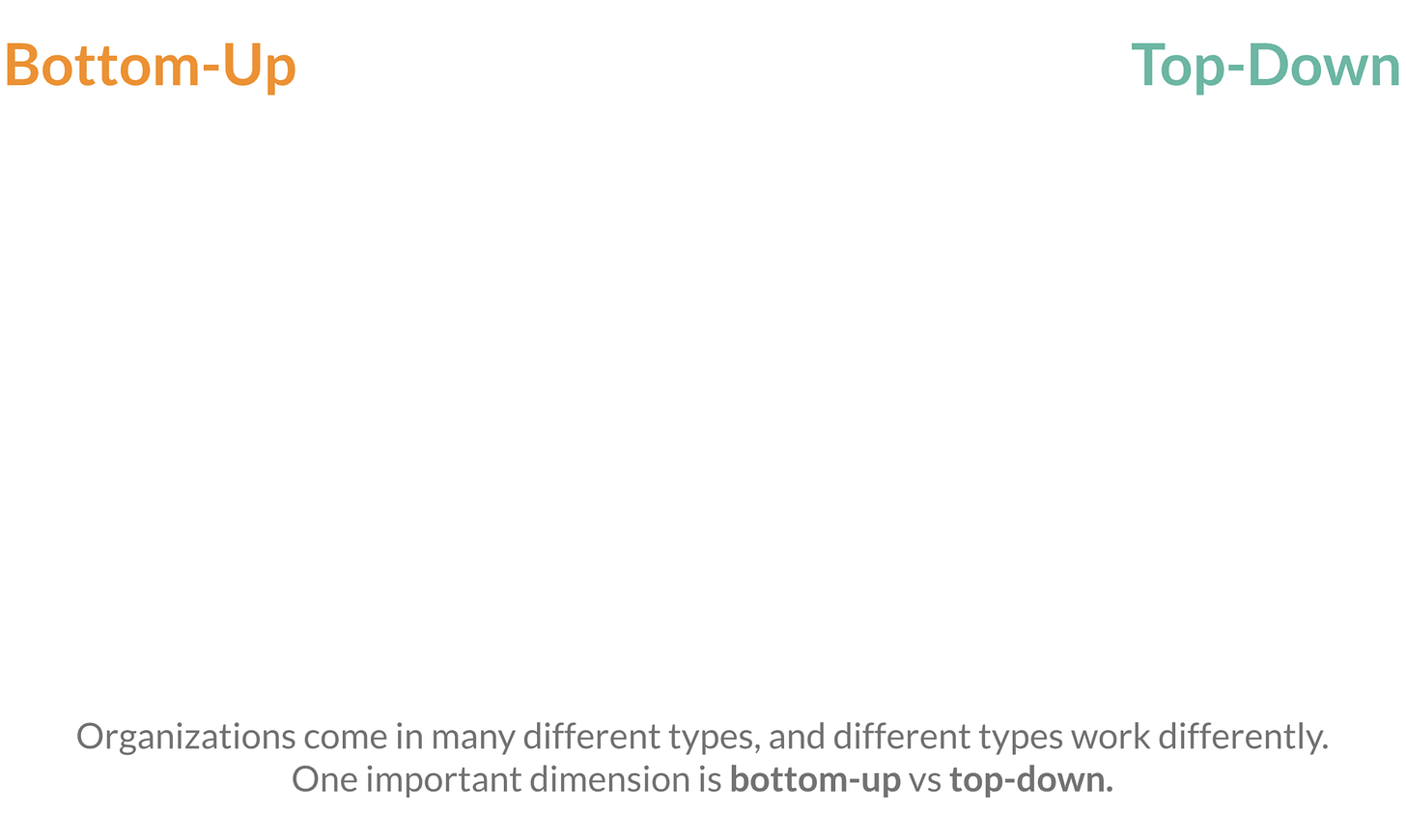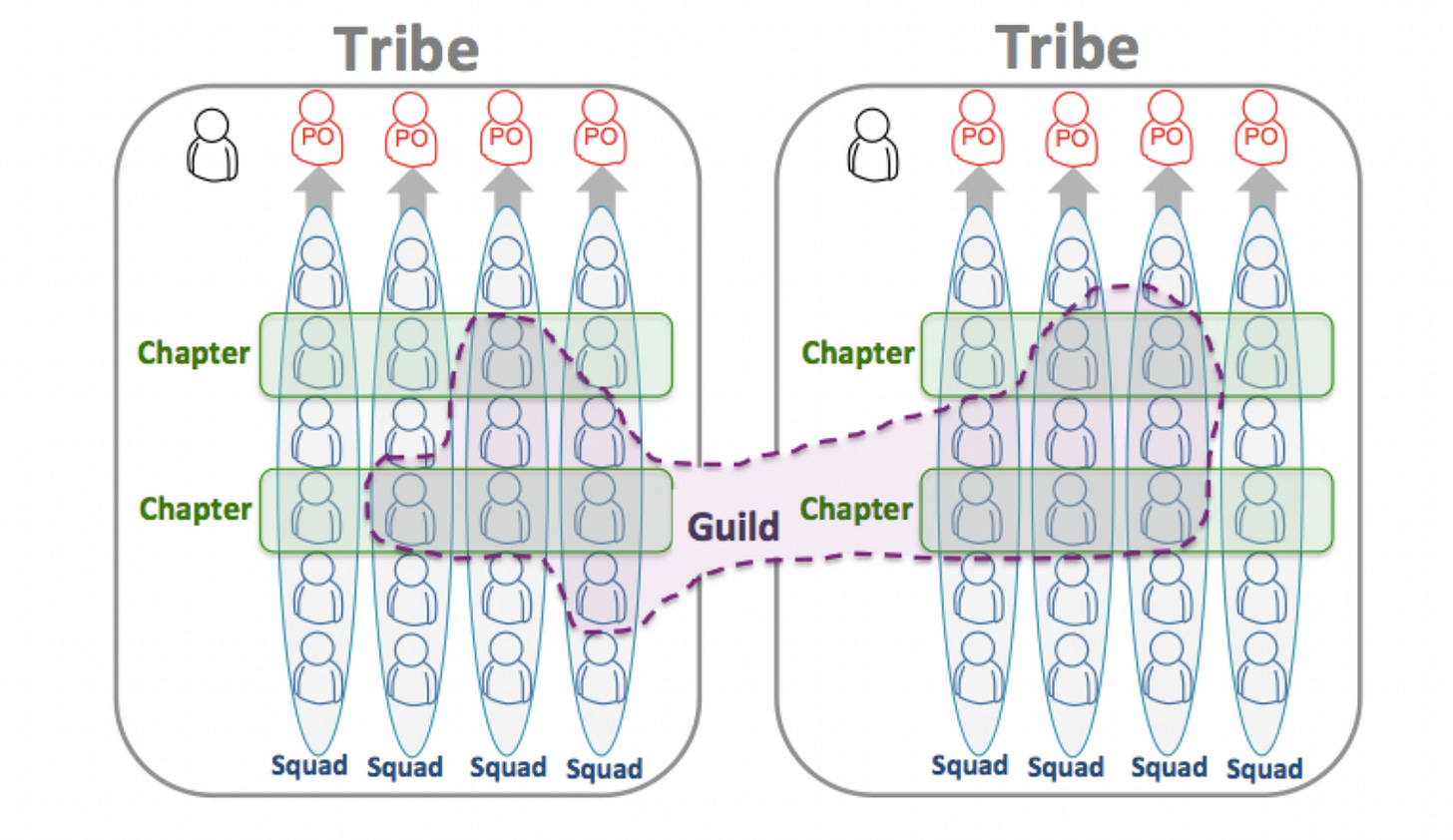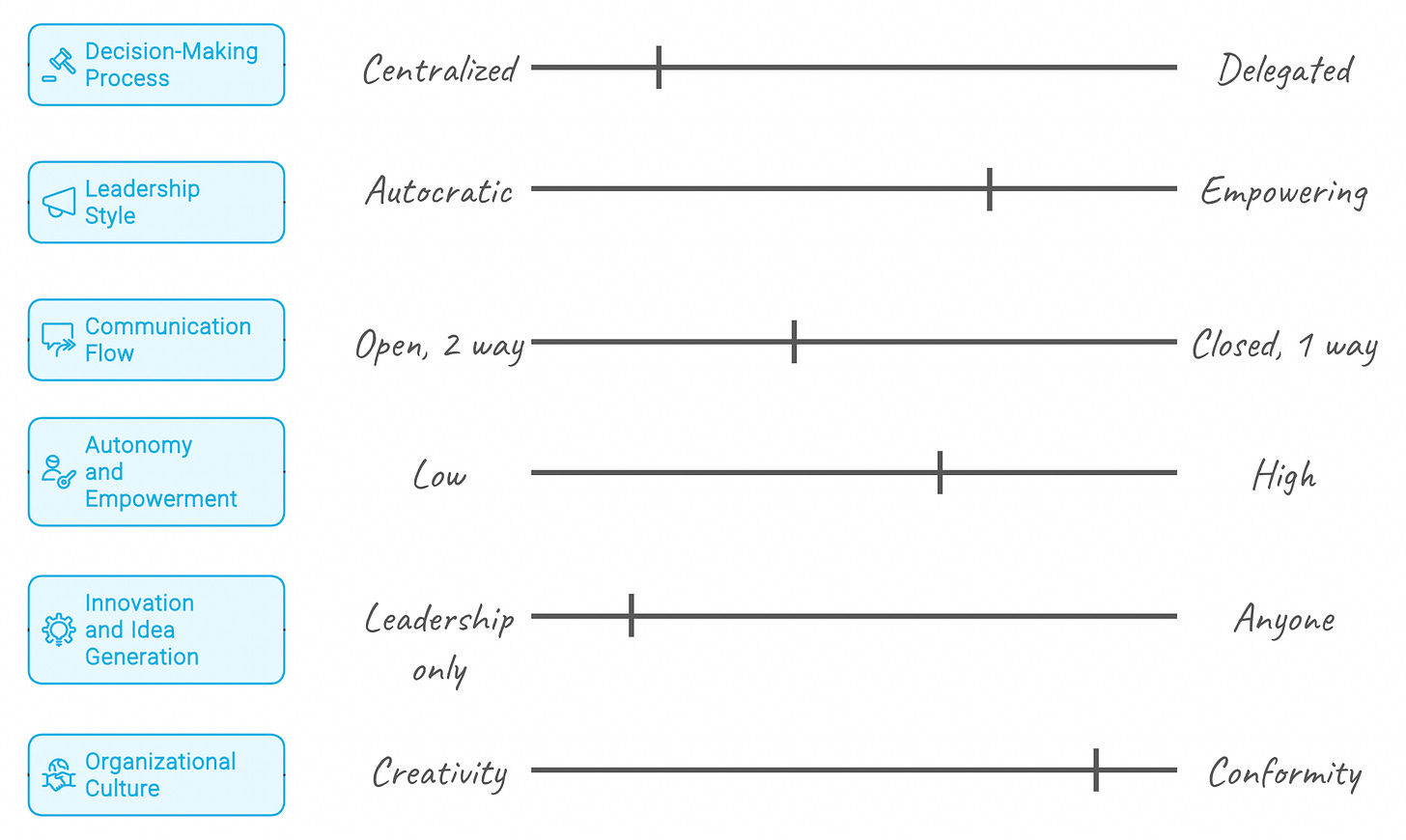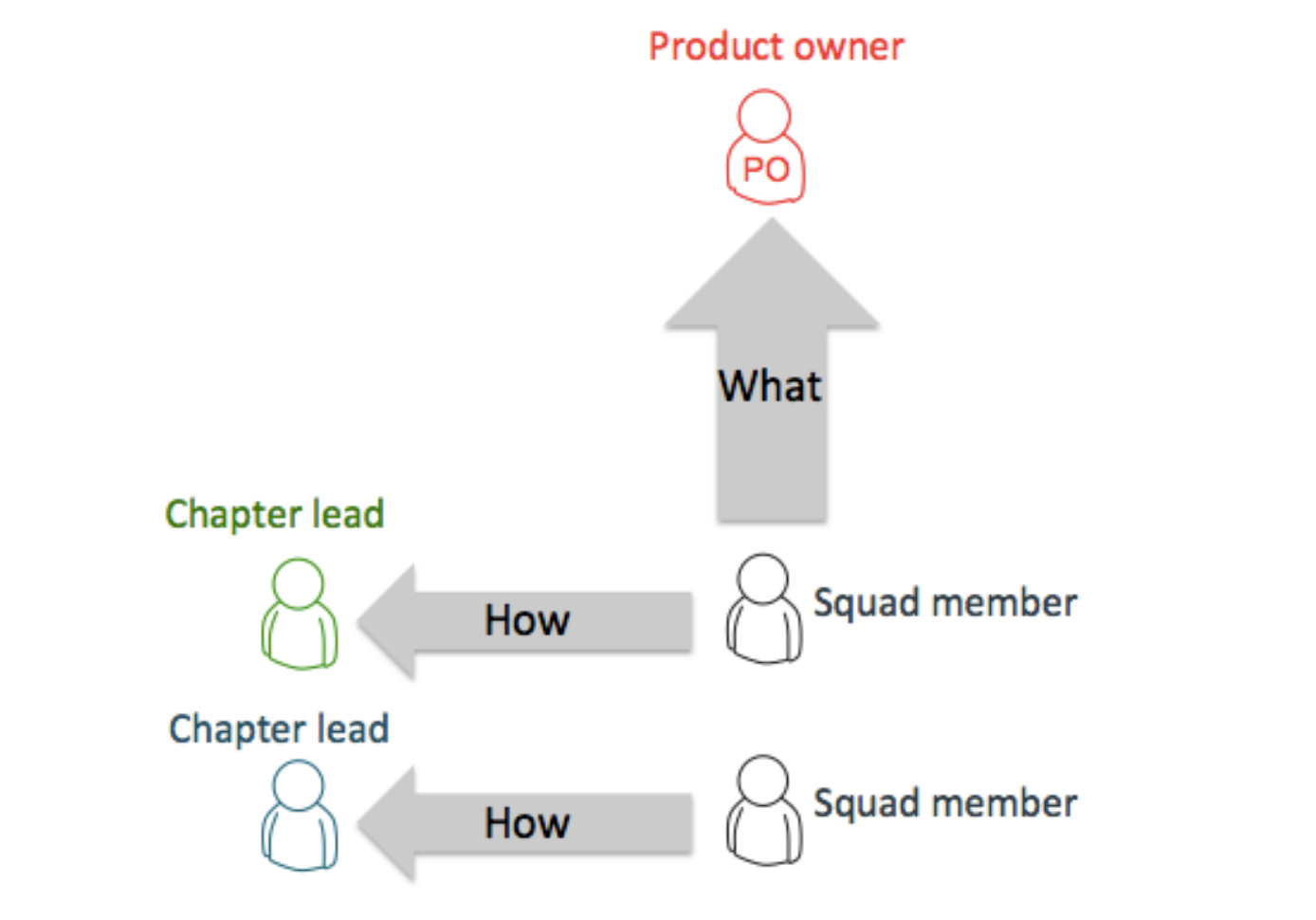GTM Zero to One: Assess Top Down vs. Bottoms Up
And lessons from using Spotify's squads & tribes org structure and a framework for assessing your org
Day 23 of writing daily. The roadmap and where we are.1

Every org needs a healthy tension between speed/breaking things and building things well.
Over time, the more you do the former, the more (potentially hidden) debt you accrue (technical, organizational, etc).
But if you’re too slow or lacking that innovative muscle, you risk falling behind and (ultimately) closing up shop.
As a first step to assess an org’s capacity for innovation (new products, innovation, GTM), I like to try and assess where it lies on a spectrum from top down 🪖 to bottoms up 🧫.
Whether you’re full-time leading a team/organization trying to evolve, transform, innovate, launch new products and services.
Or you’re consulting (or working fractionally) with an organization trying to do the same.
🛜🎧 Taking Some Lessons From Spotify
(and my experience working with a similar Squads/Tribes approach with different orgs)
The Spotify Model (originally from 2012) is now famous squads and tribes. And it worked extremely well for us during a couple scale-ups I’ve led or been part of, enabling us to achieve the magic of ‘aligned autonomy’ or loosely-coupled but tightly aligned.
It looks like matrix2, but in actuality it’s optimized for:
autonomy of each squad (owning core features/missions/user stories) and tribe (product roadmap, priorities, for a core product aspect or technical feature — also key program, service or expertise domain)
cross functionality so that each squad and tribe (and the individuals within hem)
do not need to ask permission to
a) make critical decisions to moving forward or
b) resources/talent allocated from a central authority
Signs things are going well:
🧊 We operate with tons of transparency, biasing toward over-communication and sharing for full context.
🧭 We ship lots of products, features, design updates, and things that specifically move the needle. We operate on a sprint like cadence that leads to both things (fast shipping and impact).
📊 Each team owns its KPIs, but collaborates when things go off base without blame.
🤲🏼 We get to elevate people who do excellent work.
🧳 We take time to debrief and unpack what well and what did not.
We have a productive meeting and documentation culture:
meetings have agendas, clear reasons for people invited, optional folks
you default to async comms, Slack, documents, Loom, Miro, and Confluence/Jira/Pivotal Tracker for aligning and prioritizing on what gets built, by whom, and acceptance criteria + reviews for when things are done to spec and scope
🫀 centralized functions you expect are also working well and not causing teams to stall:
finance (ROI, budgets get approved for bigger things, smaller decisions within budget are in your domain)
HR (hiring)
legal (contracts)
Worrisome signs when things begin shifting away from aligned autonomy:
🪐 Centralized vs. decentralized: Look at what’s centralized (data, engineering, fundraising) vs. distributed into teams in a matrix-like fashion; how do your program, product, business units function, where do you go for decisions and resources, and is process hampering things without also supporting efficiency and decision making
🗓️ Meetings: Too many meetings, and especially meetings which don’t have agendas, seem to creep in and take over ability to do focused, work time for yourself (ICs) or the teams you lead and collaborate with.
🤬 Blame Game: Or starting to see the blame game playout and debriefs/diagnosis are more about assigning blame for failure vs. learning from failure to inform future iterations and initiatives.
🛠️ Tools:
the seminal piece 2012 from Spotify on scaling Agile, Squads and Tribes, Guilds and Chapters
from Spotify
engineering leader (Anders Ivarsson) and
agile/scrum coach (Henrik Kniberg)
🪖 🧫 A Framework for Assessing Top-Down vs. Bottom-Up
Now of course, Top Down vs. Bottoms Up is an overly simplistic heuristic, and you don’t actually have to operate using the Spotify Model, squads or tribes. But the following framework and related questions can help you parse how top down vs. bottom-up your organization is based on key factors:
1. Decision-Making Process
Key Question: Who makes the most critical decisions in the organization?
Are decisions primarily made by senior leadership without much input from lower levels?
Are employees at various levels involved in the decision-making process?
Is there a clear process for gathering input from different levels before decisions are made?
Is something like RACI used? (in name or in actuality
2. Leadership Style
Key Question: How do leaders interact with their teams?
Do leaders dictate actions and expect compliance, or do they encourage feedback and collaboration?
Are leaders seen as distant figures, or are they approachable and involved in day-to-day operations?
How often do leaders seek input from employees when setting strategic directions?
3. Communication Flow
Key Question: How does information flow within the organization?
Is communication primarily one-way, from top to bottom?
Are there established channels for employees to voice their opinions, ideas, and concerns?
How transparent is the organization in sharing information across all levels?
4. Autonomy and Empowerment
Key Question: How much autonomy do employees have in their roles?
Are employees encouraged to take initiative and make decisions within their roles?
Is there a culture of micromanagement, or are employees trusted to execute their tasks independently?
How are employees involved in shaping the direction of their teams or the organization?
5. Innovation and Idea Generation
Key Question: Where do most new ideas and innovations come from?
Are ideas for new projects or products typically generated by senior leadership?
Are employees at all levels encouraged to contribute ideas and suggest innovations?
How are employee ideas evaluated and implemented?
6. Organizational Culture
Key Question: What behaviors and values are rewarded in the organization?
Are conformity and adherence to directives valued over creativity and initiative?
Is there a culture of collaboration and shared ownership of outcomes?
How are successes and failures handled within the organization?
🛠️ Tools:
Great pieces on scaling product teams from First Round Review:
This week’s posts will be a 5 part series breaking down the core insights and why slime molds are a powerful metaphor, and the idea of loosely coupled, tightly aligned (or ‘aligned autonomy’).
Yesterday, I gave the overview tl;dr on organizations as slime molds and the idea of loosely coupled, tightly aligned (aka aligned autonomy)
Today we’re going deeper on top down 🪖 vs. bottom up 🧫.
Wait a sec, isn’t this just a matrix org?
[copied from the original piece on this org structure at Spotify]
Yes. Well, sort of. It’s a different type of matrix than what most of us are used to though.
In many matrix organizations people with similar skills are “pooled” together into functional departments, and “assigned” to projects, and “report to” a functional manager.
Spotify rarely does any of this. Our matrix is weighted towards delivery.
That is, people are grouped into stable co-located squads, where people with different skill sets collaborate and self-organize to deliver a great product. That’s the vertical dimension in the matrix, and it is the primary one since that is how people are physically grouped and where they spend most of their time.
The horizontal dimension is for sharing knowledge, tools, and code. The job of the chapter lead is to facilitate and support this.
In matrix terms, think of the vertical dimension as “what” and the horizontal dimension as “how”. The matrix structure ensures that each squad member can get guidance on “what to build next” as well as “how to build it well.
This matches the “professor and entrepreneur” model recommended by Mary and Tom Poppendieck. The PO is the “entrepreneur” or “product champion”, focusing on delivering a great product, while the chapter lead is the “professor” or “competency leader”, focusing on technical excellence.
There is a healthy tension between these roles, as the entrepreneur tends to want to speed up and cut corners, while the professor tends to want to slow down and build things properly. Both aspects are needed, that’s why it is a “healthy” tension.



